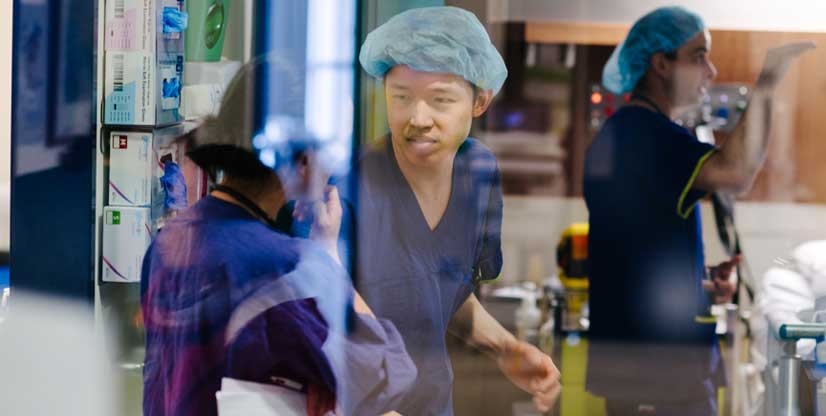About
3D printing medical equipment in response to COVID-19
- Home
- About
- Latest news
- All news
- Archived news 2020
- 3D printing medical equipment in response to COVID-19
PPE hoods are something that anaesthetists, nurses and surgeons commonly wear to protect themselves when performing procedures that cause patients with suspected or confirmed COVID-19 to generate potentially infectious aerosols.
Anaesthetists Dr Lachlan Miles, Dr Daniel Banyasz and Dr Tim Makar found that the disposable surgical gowns worn on top of these hoods to keep them sterile, were being sucked into the powered air-purifying respirator (PAPR).
“The PAPR machine ensures you’re breathing clean, filtered air. It also generates positive pressure inside the hood that creates barrier and stops infectious particles from entering.
“Because the surgical gowns were being sucked into the PAPR filters and limiting its effectiveness, we ‘MacGyvered’ a solution out of repurposed anaesthetic equipment secured with Blu Tack, but this wasn’t a long-term or sustainable option,” Dr Lachlan Miles said.
They then reached out to Associate Professor Jason Chuen and Dr Jasamine Coles-Black who run Austin Health’s 3DMedLab to help engineer a solution.
Medical 3D printing uses digital technology to create or 'print' 3D models of body parts and other objects that are used in a range of ways including planning and performing surgical procedures.
Working together with the University of Melbourne’s Engineering and Design Schools, it took less than three days to develop and print a solution to this problem.
“We call this invention ‘the spider’ it’s a cage/clip that effectively stops the surgical gowns form getting sucked into the PARP. So far, we’ve 3D printed over 100 of them, which are single use.
“These are fairly cheap to make, at less than 50 cents a pop and at the moment we’re trying to organise for a commercial manufacturer to produce them in bulk,” said A/Prof Chuen.
“Our Medical 3D printing lab is always looking to identify problems in the clinical realm and try to match-up engineering solutions.
“I’m proud of what we’ve achieved by working together, especially the final design from Ryan Pennings at the Melbourne School of Design,” he said.
A paper on this has recently been published in the journal Anaesthesia Reports.
Watch how 3DMedLab prints the 'spider'.

Nurse Dallas Hamilton wearing the PPE hood and 3D printed 'spider' that keeps surgical gowns from being sucked into the PAPR.

A close up look at the 'spider' attached to the PAPR.






